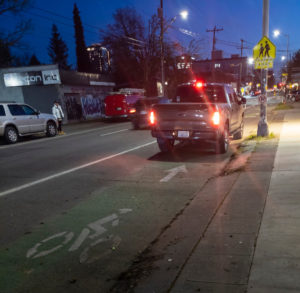Do you know why drivers and pedestrians usually feel safe?. Because there is a concrete border separating them. That, and a row of parked cars, traffic lights, street lights, mailboxes, trash cans, bicycle racks, trees, bollards and what not.
When I ask people the main reason they don’t bike, it’s because they don’t think it’s safe. And I can’t blame them if in your city the only thing between you and speeding cars is paint.

I just took the picture above a couple days ago. Do you see the big car, parked in the middle of the bikeway, next to a not parking sign?. You may wonder what was it doing there. Well, it was there because, while driving on the paint only bikeway, it almost ran over a biker. And this isn’t an isolated incident. When I bike I see cars taking the paint-only or flex post bikeway daily. You name it: ambulances, UPS/ Fedex vans, moving companies, Ubers, pizza deliveries, random drivers, etc. Most drivers do indeed respect paint-only bikeways, but with the amount of people driving, a small percentage of inconsiderate drivers keep a lot of people from biking.
A few days ago I found this tweet, and the question is totally legit. That temporary bike way, separated with big, plastic Jersey walls, is much safer than regular bike ways.
So what are the alternatives when it comes to borders for bikeways? Let’s see:
- Paint: Low initial cost but ineffective with careless drivers. They need to be repainted as cars run over them.
- Parking spots: Low initial cost and effective with careless drivers when occupied.
- Flex posts: Moderate initial cost but ineffective with careless drivers. The posts need to be replaced as cars run over them. I’ve seen a whole street of flex posts lacking half of them in half a year.
- Small border (half a feet tall): Moderate cost, small physical barrier, inconsiderate drivers will hit it before running over bikers, but they need to be replaced and realigned as drivers hitting them also move them.
- Bollards: Moderate cost, visible from the driver perspective, will only work against inconsiderate drivers if they are made of and filled with steel and concrete.
- Vegetation (planters, bushes, trees, etc): Higher cost plus periodic maintenance, improve air quality, but must be kept trimmed so they don’t reduce visibility.
- Big barrier (as in concrete or plastic Jersey walls, etc): Higher cost, large physical barrier, very visible from the driver perspective, careless drivers will have almost no effect on bikers.
- Detached (as in there’s a small sidewalk between the bikeway and the drivers): Higher initial cost but really safe against inconsiderate drivers.
Also, relying on borders alone to protect bikers from inconsiderate drivers is a bad idea. Borders complement an environment with enforced and reduced speed limits. Here in Seattle most streets are limited to 25mpm/40kmh. Meanwhile, in cities like Copenhagen or Barcelona it’s 30kmh/20mph.
Another thing to take into account is consistency: I’ve biked in cities where the bikeways were painted green, red, empty, and sometimes asked people to bike on the right while other times they asked we ride on the left. You’d never do that to pedestrians or drivers. So choose the best way (ideally look at the Netherlands and Denmark) and replicate it all over the city.